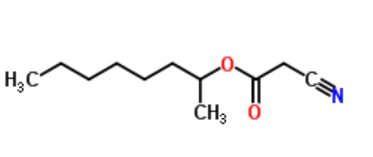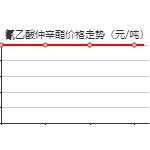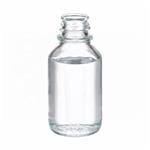The uses of cyanoacetic acid 1-methylheptyl ester as medical adhesive
Description
The mechanism of action of cyanoacrylates is derived from their Spontaneous polymerization on contact with liquids or bases.

Uses
In the urinary tract, some success was first achieved in 1978 with the use of fluoroalkyl cyanoacrylate as an adjunct to suture in canine ureteroureterostomy. However, because the alkyl chains of these earlier cyanoacrylates were short, they degraded rapidly into cyanoacetate and formaldehyde, which led to significant histotoxicity. Cyanoacrylates with longer alkyl chains were developed to slow the formation of these toxic degradation products, such as N-butyl 2-cyanoacrylate.
However, the isobutyl form of this adhesive was implicated as having induced sarcoma when it was implanted into the peritoneum of rats. 2-octyl cyanoacrylate (2-OCYA) is a cyanoacrylate with a long alkyl chain and it was approved for skin wound closure in the United States after randomized controlled testing in 1997. In the laboratory setting, some success has been achieved using 2-OCYA in microvascular anastomosis of the rat femoral artery. An advantage is that it can be easily and quickly applied.
A study on vesicourethral anastomosis with 2-octyl cyanoacrylate in vivo canine to see the medical adhesive function [1]. To evaluate the effectiveness of 2-OCYA in the formation of vesicourethral anastomoses, open total prostatectomy was performed on 12 mongrel hounds. Of these, 8 had a vesicourethral anastomosis formed using 2-OCYA (4 with suture support and 4 sutureless). The remaining four anastomoses were conventionally formed using eight interrupted sutures. Acute leakage was tested intraoperatively. Before killing the hounds, the anastomosis of 1 animal in each group was assessed on postoperative days 3, 5, 7, and 14 by radiography. Each anastomotic specimen was then tested for leak pressure and examined histologically. At intraoperative testing, one small leak was found in the sutureless 2-OCYA group. All other anastomoses were watertight intraoperatively.
Radiographically, two leaks occurred in the 2-OCYA group with suture support, three leaks in the sutureless 2-OCYA group, and only one small localized leak in the control group. Only one of the eight anastomoses using 2-OCYA achieved a physiologic leak pressure greater than 70mm Hg. The leak pressures of all four control-group anastomoses were 70 mm Hg or greater. Histologically, no significant differences were found in healing between the control and 2-OCYA anastomoses. However, research results also demonstrated that 2-OCYA appears to be unsuitable for use in forming the large-diameter vesicourethral anastomosis required in radical prostatectomy.
Another case is 2-OCYA works as a medical adhesive in the treatment of a corneal perforation. In the experiment process, 2-OCYA was applied at the slit lamp with topical proparacaine anesthesia to a cornea with an inferior perforation with iris plugging the defect. After application of 2-OCYA, the anterior chamber was noted to deepen, and visual acuity improved to 20/200. The glue remained intact for more than 6 weeks and eventually fell out. The underlying cornea healed without scarring, vascularization, or thinning. The results demonstrated that 2-OCYA was used to treat a corneal perforation with excellent results. Further study of this adhesive will be useful in comparing the effectiveness and safety of 2-OCYA with that of previously studied adhesives [2].
References
[1] Jeremy P Grummet, etc., Vesicourethral anastomosis with 2-octyl cyanoacrylate adhesive in an in vivo canine model, Urology, Volume 60, Issue 5, November 2002, 935-938
[2] Taravella, Michael J. M.D., etc., 2-Octyl Cyanoacrylate Medical Adhesive in Treatment of a Corneal Perforation, Cornea: March 2001 - Volume 20 - Issue 2 - p 220-221
);You may like
See also
Lastest Price from 2-Octyl cyanoacetate manufacturers

US $8.00-1.00/KG2024-03-29
- CAS:
- 52688-08-1
- Min. Order:
- 1KG
- Purity:
- 99%
- Supply Ability:
- g-kg-tons, free sample is available

US $40.00-40.00/kg2023-12-11
- CAS:
- 52688-08-1
- Min. Order:
- 1kg
- Purity:
- 0.99
- Supply Ability:
- 10 tons

![2,4-Dichlorothieno[3,2-d] pyrimidineSynthesis of 2,4-Dichlorothieno[3,2-d] pyrimidine](httpss://www.chemicalbook.com/NewsImg/2019-12-5/201912517264220540.png)
